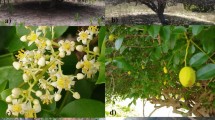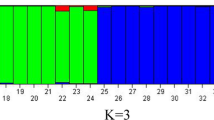Abstract
The genus Origanum is often referred to as an under-utilized taxon because of its complex taxonomy. Origanum vulgare L., the most variable species of the genus, is a spice and medicinal herb that is characterized by high morphological diversity (six subspecies). In this study, the relative efficiencies of two PCR-based marker approaches, amplified fragment length polymorphism (AFLP) and selectively amplified microsatellite polymorphic loci (SAMPL), were used for comparable genetic diversity surveys and subspecies discrimination among 42 oregano accessions. Seven assays each of AFLP and SAMPL markers were utilized. Effective multiplex ratio (EMR), average heterozygosity (Hav-p), marker index (MI), and resolving power (RP) of the primer combinations were calculated for the two marker systems. UPGMA and Structure analysis along with PCoA plots derived from the binary data matrices of the two markers depicted the genetic distinction of accessions. Our results indicate that both marker systems are suitable but SAMPL markers are slightly more efficient in differentiating accessions and subspecies than AFLPs.



Similar content being viewed by others
References
Altintas S, Toklu F, Kafkas S, Kilian B, Brandolini A, Özkan H (2008) Estimating genetic diversity in durum and bread wheat cultivars from Turkey using AFLP and SAMPL markers. Plant Breeding 127:9–14
Ayanoglu F, Ergül A, Arslan M (2006) Assessment of genetic diversity in Turkish oregano (Origanum onites L.) germplasm by AFLP analysis. J Hortic Sci Biotech 81:45–50
Bakkali F, Averbeck S, Averbeck D, Idaomar M (2008) Biological effects of essential oils—a review. Food Chem Toxicol 46:446–475
Bolibok H, Rakoczy-Trojanowska M, Hromada A, Pietrzykowski R (2005) Efficiency of different PCR-based marker systems in assessing genetic diversity among winter rye (Secale cereale L.) inbred lines. Euphytica 146:109–116
Chalchat JC, Pasquier B (1998) Morphological and chemical studies of origanum clones: Origanum vulgare L. ssp vulgare. J Essent Oil Res 10:119–125
D’Antuono LF, Galleti GC, Bocchini P (2000) Variability of essential oil content and composition of Origanum vulgare L. populations from a North Mediterranean Area (Liguria Region, Northern Italy). Ann Bot 86:471–478
Dice LR (1945) Measures of the amount of ecologic association between species. Ecology 26:297–302
Doyle JF, Doyle JL (1990) A rapid DNA isolation procedure for small quantities of fresh leaf tissue. Focus 12:13–15
Falush D, Stephens M, Pritchard JK (2007) Inference of population structure using multilocus genotype data: dominant markers and null alleles. Mol Ecol Notes 7:574–578
Hubisz MJ, Falush D, Stephens M, Pritchard JK (2009) Inferring weak population structure with the assistance of sample group information. Mol. Ecol. Resour. doi: 10.1111/j.1755-0998.2009.02591.x
Ietswaart JH (1980) A taxonomic revision of the genus Origanum (Labiatae), Leiden botanical series, vol 4. Leiden University Press, The Hague, Leiden
Johnson EL, Zhang D, Emche SD (2005) Inter- and intra-specific variation among five Erythroxylum taxa assessed by AFLP. Ann Bot 95:601–608
Karp A, Kresovich S, Bhat KV, Ayad WG, Hodgkin T (1997) Molecular tools in plant genetic resources conservation: a guide to the technologies. IPGRI technical bulletin no. 2. International Plant Genetic Resources Institute, Rome, Italy
Kaufmann M, Wink M (1994) Molecular systematics of the Nepetoideae (family Labiatae): phylogenetic implications from rbcL gene sequences. Z Naturforsch 49:635–645
Khan SA, Hussain D, Askari E, Stewart JMCD, Malik KA, Zafar Y (2000) Molecular phylogeny of Gossypium species by DNA fingerprinting. Theor Appl Genet 101:931–938
Klocke E, Langbehn J, Grewe C, Pank F (2002) DNA Fingerprinting by RAPD on Origanum majorana L. J Herbs, Spices and Med Plants 9:171–176
Kokkini S (1997) Taxonomy, diversity and distribution of Origanum species. In: Padulosi S (ed) Oregano, 14. Proceedings of the IPGRI international workshop. Italy, Rome, pp 2–12
Kokkini S, Vokou D (1989) Carvacrol-rich plants in Greece. Flavour Frag J 4:1–7
Kulisic T, Radoni A, Katalinic V, Milos M (2004) Use of different methods for testing antioxidative activity of oregano essential oil. Food Chem 85:633–640
Mantel NA (1967) The detection of disease clustering and a generalized regression approach. Cancer Res 27:209–220
Mastro GD (1997) Crop domestication and variability within accessions of Origanum genus. In: Padulosi S (ed) Oregano, 14. Proceedings of the IPGRI international workshop. Italy, Rome, pp 34–48
Milbourne D, Meyer R, Bradshaw JE, Baird E, Bonar N, Provan J, Powell W, Waugh R (1997) Comparison of PCR-based marker systems for the analysis of genetic relationships in cultivated potato. Mol Breeding 3:127–136
Monteleone I, Ferrazzini D, Belletti P (2006) Effectiveness of neutral RAPD markers to detect genetic divergence between the subspecies uncinata and mugo of Pinus mugo Turra. Silva Fenn 40:391–406
Mueller UG, Wolfenbarger LL (1999) AFLP genotyping and fingerprinting. Trends Ecol Evol 14:389–394
Negi MS, Sabharwal V, Wilson N, Lakshmikumaran MS (2006) Comparative analysis of the efficiency of SAMPL and AFLP in assessing genetic relationships among Withania somnifera genotypes. Current Sci 25:464–472
Novak J, Lukas B, Bolzer K, Grausgruber-Gröger S, Degenhardt J (2007) Identification and characterization of simple sequence repeat markers from a glandular Origanum vulgare expressed sequence tag. Mol Ecol Notes 8:599–601
Nybom H, Weising K (2007) DNA profiling of plants. In: Kayser O, Quax WJ (eds) Medicinal plants biotechnology, from basic to industrial applications. Wiley-VCH, Weinheim, pp 73–95
Olivier GW (1997) The world market of oregano. In: Padulosi S (ed) Oregano, 14. Proceedings of the IPGRI international workshop. Italy, Rome, pp 141–145
Passinho-Soares H, Felix D, Kaplan MA, Margis-Pinheiro M, Margis R (2006) Authentication of medicinal plant botanical identity by amplified fragmented length polymorphism dominant DNA marker: inferences from the plectranthus genus. Planta Med 72:929–931
Powell W, Morgante M, Andre C, Hanafey M, Vogel J, Tingey S, Rafalski A (1996) The comparison of RFLP, RAPD, AFLP and SSR (microsatellite) markers for germplasm analysis. Mol Breeding 2:225–238
Prevost A, Wilkinson MJ (1999) A new system of comparing PCR primers applied to ISSR fingerprinting of potato cultivars. Theor Appl Genet 98:107–112
Pritchard JK, Stephens M, Donnelly P (2000) Inference of population structure using multilocus genotype data. Genetics 155:945–959
Putievsky E, Dudai N, Ravid U (1997) Cultivation, selection and conservation of oregano species in Israel. In: Padulosi S (ed) Oregano, 14. Proceedings of the IPGRI international workshop. Italy, Rome, pp 102–109
Raina SN, Rani V, Kojima T, Ogihara Y, Singh KP, Devarumath RM (2001) RAPD and ISSR fingerprints as useful genetic markers for analysis of genetic diversity, varietal identification, and phylogenetic relationships in peanut (Arachis hypogaea) cultivars and wild species. Genome 44:763–772
Rakoczy-Trojanowska M, Bolibok H (2004) Characteristics and comparison of three classes of microsatellite-based markers and their application in plants. Cell Mol Biol Lett 9:221–238
Rohlf FJ (2000) NTSYS-pc numerical taxonomy and multivariate analysis system, version 2.20e. Exeter Publication, New York
Rohlf FJ, Fisher DL (1968) Test for hierarchical structure in random data set. Syst Zool 17:407–412
Roldan-Ruiz I, Dendauw J, van Brokstaele E, Depicker A, de Loose A (2000) AFLP markers reveal high polymorphic rates in ryegrass (Lolium spp.). Mol Breeding 6:125–134
Roy JK, Lakshmikumaran MS, Balyan HS, Gupta PK (2004) AFLP-based genetic diversity and its comparison with diversity based on SSR, SAMPL, and phenotypic traits in bread wheat. Biochem Genet 42:43–59
Sarwat M, Das S, Srivastava PS (2008) Analysis of genetic diversity through AFLP, SAMPL, ISSR and RAPD markers in Tribulus terrestris, a medicinal herb. Plant Cell Rep 27:519–528
Singh A, Chaudhury A, Srivastava PS, Lakshmikumaran M (2002) Comparison of AFLP and SAMPL markers for assessment of intra population genetic variation in Azadirachta indica A. Juss. Plant Sci 162:17–25
Skoula M, Harborne JB (2002) Taxonomy and chemistry. In: Kintzios SE (ed) Oregano: the genera Origanum and Lippia. Medicinal and aromatic plants—industrial profiles, vol 25. Taylor & Francis CRC Press, USA, pp 67–108
Spataro G, Taviani P, Negri V (2007) Genetic variation and population structure in a Eurasian collection of Isatis tinctoria L. Genet Resour Crop Evol 54:573–584
Tosti N, Negri V (2002) Efficiency of three PCR-based markers in assessing genetic variation among cowpea (Vigna unguiculata subsp. unguiculata) landraces. Genome 45:268–275
Vogel JM, Scolnik PA (1998) Direct amplification from microsatellites: detection of simple repeat-based polymorphisms without cloning. In: Caetano-Anolles G, Gresshoff PM (eds) DNA markers, protocols, applications, and overviews. Wiley–Liss, New York, pp 133–150
Vos P, Hogers R, Bleeker M, van de Lee T, Hornes M, Frijters A, Pot J, Peleman J, Kuiper M, Zabeau M (1995) AFLP: a new technique for DNA fingerprinting. Nucleic Acids Res 23:4407–4444
Wollf K, Morgan-Richards M (1998) PCR markers distinguish Plantago major subspecies. Theor Appl Genet 96:282–286
Acknowledgments
Financial support by the German Academic Exchange Service (DAAD) through a PhD scholarship to Ali Azizi is gratefully acknowledged. The authors are also grateful to IPK, Gatersleben, Germany, for seed stocks. We also wish to thank Dr Rod Snowdon, Giessen, for critical reading of the manuscript.
Author information
Authors and Affiliations
Corresponding author
Rights and permissions
About this article
Cite this article
Azizi, A., Wagner, C., Honermeier, B. et al. Intraspecific diversity and relationship between subspecies of Origanum vulgare revealed by comparative AFLP and SAMPL marker analysis. Plant Syst Evol 281, 151–160 (2009). https://doi.org/10.1007/s00606-009-0197-1
Received:
Accepted:
Published:
Issue Date:
DOI: https://doi.org/10.1007/s00606-009-0197-1




